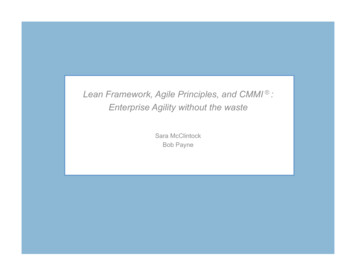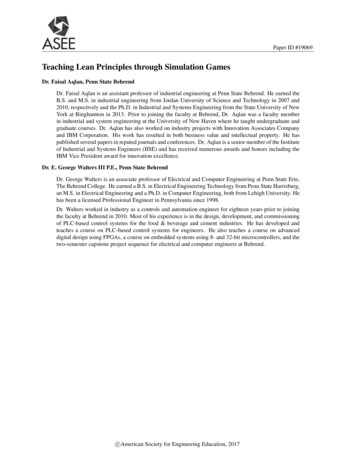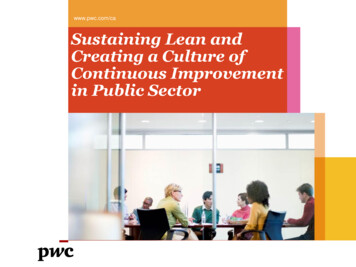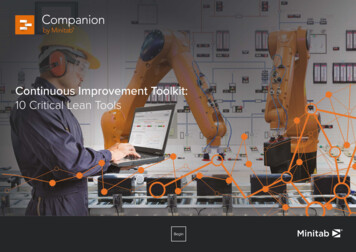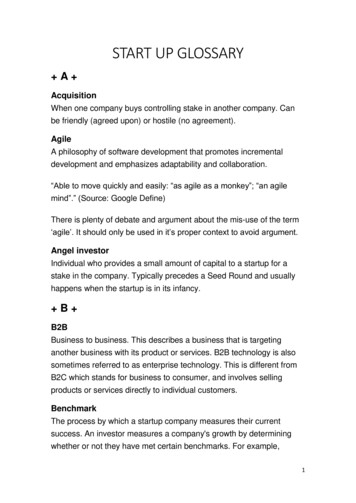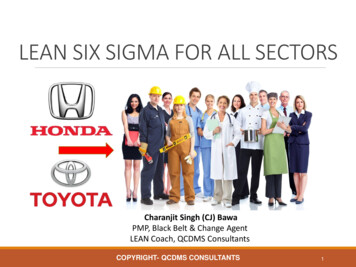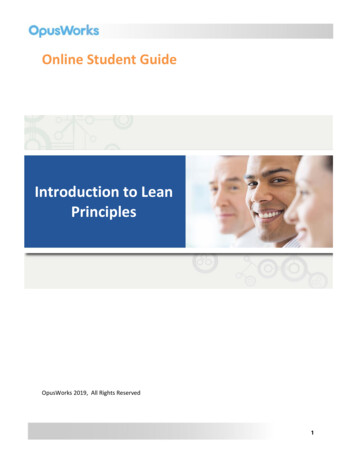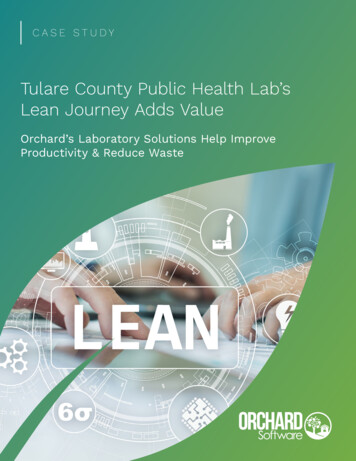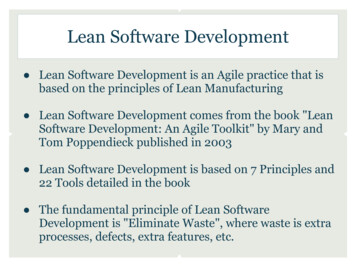
Transcription
Lean Software Development Lean Software Development is an Agile practice that isbased on the principles of Lean Manufacturing Lean Software Development comes from the book "LeanSoftware Development: An Agile Toolkit" by Mary andTom Poppendieck published in 2003 Lean Software Development is based on 7 Principles and22 Tools detailed in the book The fundamental principle of Lean SoftwareDevelopment is "Eliminate Waste", where waste is extraprocesses, defects, extra features, etc.
Lean SoftwareDevelopmentChris BubernakMarc SchweikertCSCI 5828March 23, 2012
Agenda Lean History Who Uses Lean? 7 Principles Eliminate WasteAmplify LearningDecide as Late as PossibleDeliver as Fast as PossibleEmpower the TeamBuild Integrity InSee the Whole References
Lean History (I) Lean is a translation of Lean manufacturingand IT practices into the softwaredevelopment domain Lean manufacturing itself is derived fromthe Toyota Production System (TPS) The term "Lean Software Development"comes from the book "Lean SoftwareDevelopment: An Agile Toolkit" written byTom & Mary Poppendieck in 2003 The book lays out 7 Principles and 22 Toolsthat encapsulate the Lean process
Lean History (II) The fundamental Lean principle is EliminateWaste According to the father of the TPS, TaiichiOhno, waste is defined as anything that doesnot produce value for the customer Designs and prototypes are not useful to thecustomer; they are only valuable when thenew product is delivered
Who Uses Lean? Many software development companiesemploy agile development lifecycles andmake use of Lean principles XeroxRally SoftwarePatient KeeperHelphireCorbis
Eliminate Waste (I) Tool #1: Seeing Waste Agile practices seek to eliminate waste, but the firststep is to learn how to see waste Good examples of waste are parts of the softwareprocess that are not analysis and coding - do theyreally add value to the customer? Shigeo Shingo identified seven types ofmanufacturing waste Mary and Tom Poppendieck translated these into thesoftware domain in the following table
Eliminate Waste (II)Manufacturing WasteSoftware Development WasteInventoryPartially Done WorkExtra ProcessingExtra ProcessesOverproductionExtra FeaturesTransportationTask SwitchingWaitingWaitingMotionMotionDefectsDefects
Eliminate Waste (III) Partially Done Work Partially done software has a tendency to become obsolete You have no idea if it will eventually work You don't know if it will solve the business problem Ties up resources in investments that have yet to produce results Minimizing partially done software reduces risk and waste
Eliminate Waste (IV) Extra Processes Paperwork consumes resources, slows down response time, hides quality problems, gets lost, becomes degraded and obsoletePaperwork that nobody reads adds no value to the customerMany development processes require paperwork for customersign-off or to get approval for a changeJust because paperwork is required does not mean that it addsvalueGood paperwork are documents that someone is waiting to beproduced so they can do their jobA good alternative to writing requirements is writing customertests (like Cucumber!)
Eliminate Waste (V) Extra Features Developers sometimes like to add extra features to a system just in case they are needed This seems harmless, but this is serious wasteAll of the code has to be tracked, compiled, integrated, and testedEvery bit of code adds complexity and may become a failure pointThe extra code may become obsolete before it is usedIf the code isn't needed now, putting it in the system is waste
Eliminate Waste (VI) Task Switching Assigning people to multiple projects is a source of waste When a developer switches tasks, significant switching time is needed to gather his/her thoughts and get into the flowThe fastest way to complete two projects is to do themsequentiallyReleasing too much work into a software developmentorganization creates a lot of wasteWork progresses faster through a pipeline that is not filled tocapacity
Eliminate Waste (VII) Waiting A lot of time is wasted waiting for things to happen Delays in starting a project Delays in staffing Delays due to excessive requirements documentation Delays in reviews and approvals Delays in testing Delays in deploymentDelays keep the customer from seeing value as soon as possible
Eliminate Waste (VIII) Motion How much time does it take to answer a question? Are the right people staffed to answer technical questions? Is the customer readily accessible to discuss features? Development requires great concentration and chasing an answer to a question takes more time than you may thinkAgile lifecycles generally promote a shared workspace somovement is minimizedEach handoff of design artifacts is an opportunity for wasteThe biggest waste in document handoffs is that the documentitself does not contain all of the information that the next personneeds to know
Eliminate Waste (IX) Defects The amount of waste caused by a defect is determined by its impact and the amount of time it goes undetectedA critical defect detected in minutes is not a big wasteA minor defect not discovered for weeks is a much bigger wasteStrive to detect defects sooner through short iterations Management Activities Management activities do not add value to a product, but they have a large impact on waste in the organizationIf work is moved in a just-in-time manner then sophisticatedproject tracking systems are unnecessary
Eliminate Waste (X) Tool #2: Value Stream Mapping Mapping your value stream is a good way to startdiscovering waste in your process This involves drawing a chart of the averagecustomer request, from arrival to completion At the bottom, draw a timeline that shows how muchtime the request spends in value-adding, waiting,and non-value-adding activities An agile value stream map follows on the next slide
Eliminate Waste (XI)
Amplify Learning (I) Tool #3: Feedback Feedback adds complexity to a system, but it alsoadds considerable value For example, a traffic light that senses cars is more useful than atraffic light on a strict timer The Waterfall development model does not provide much feedback; it is generally thought of as a singlepass modelTraditional processes consider feedback loopsthreatening because incorporating feedback couldmodify the predetermined plan
Amplify Learning (II) Increasing feedback is the single most effective wayto deal with troubled software projects Instead of letting defects accumulate, run tests as soon as the code is writtenInstead of adding more documentation or detailed planning,check out ideas by writing codeInstead of gathering more requirements, show the customer anassortment of potential users screens and get their inputInstead of studying which tool to use, bring the top threecandidates in-house and test them Developers should know their immediate customerand have ways for that customer to provide feedback
Amplify Learning (III) Tool #4: Iterations Iterations provide a dramatic increase in feedback The operational environment is considered early Design problems are exposed early Change-tolerance is built into the system Short iterations allow the system to respond to factsrather than forecasts Iterations are a point of synchronization between thedifferent teams and the customer Iterations force decisions to be made because thesystem is deployed early and often
Amplify Learning (IV) Iteration Planning The goal is to implement a coherent set of features each iteration If a feature cannot be delivered in a single iteration, then it should be broken down into smaller featuresIf iterations are short and delivery is reliable, then the customerwon't mind waiting until the next iteration for a feature
Amplify Learning (V) Team Commitment The team must be small and have the necessary expertise The team must have enough information about the features to decide how many features are in an iterationThe team must have the resources it needsTeam members have the freedom, support, and skill to figure outhow to meet their commitmentsThe team must have a basic environment for good programming
Amplify Learning (VI) Convergence There is reluctance to use iterations because there is a concern that the project will continue indefinitelyThe iterative process limits customer requests to the beginning ofeach iteration and the team concentrates on delivering thefeatures it committed to Negotiable Scope A good strategy to achieve convergence is to work the top priority items first, leaving the low priority tasks to fall off the listLet the customer only ask for their highest priority features,deliver quickly, and repeat will result in short lists of what'simportant
Amplify Learning (VII) Tool #5: Synchronization Synch and Stabilize Build the system every day after a small batch of work has been completed by each of the developersAt the end of the day, a build takes place followed by anautomated set of testsIf the build works and the tests pass, then the developers havebeen synchronizedThe more builds, the better because it provides rapid feedbackFull system tests should be run as frequently as possible
Amplify Learning (VIII) Spanning Application A way to synchronize the work of several teams is by having a small advance team develop a simple spanning applicationthrough the systemIf possible, the spanning application should go into productionWhen the spanning application is proven in production, you knowyou have a workable approach and multiple teams can use thesame approachSpanning applications can also be used to test various commercialcomponents to select the best fit for your environment
Amplify Learning (IX) Matrix A traditional approach to synchronizing multiple teams is tocreate an overall architecture and then have teams developseparate components This approach is appropriate when the teams are not co-located This approach has the advantage that the highest risk areas aretackled at the beginning of the project when there is plenty of timeand money and no code to changeThe problem with this, however, are the component interfacesTo combat this, the matrix approach starts by designing theinterfaces and then moves to the components
Amplify Learning (X) Tool #6: Set-Based Development Set-Based Versus Point-Based The point-based approach starts with one choice and is refined until it works, which takes many iterations and might notconvergeThe set-based approach starts by defining everyone's constraintsand then selects a choice that fits into those constraintsSet-based development bases communication on constraintsrather than choices which requires significantly less data toconvey far more informationTalking about constraints allows developers to defer makingchoices until the last possible moment
Amplify Learning (XI) Develop Multiple Options It might seem wasteful to develop multiple solutions, but set-baseddevelopment can lead to better solutions fasterCommunicate Constraints When you have a difficult problem, develop a set of solutions, see how theyactually work, and merge the best features of the solutionsAggressive refactoring is the key to making sure that iterative developmentconverges to a solutionImplementing a design that is available for refactoring is similar to a prototypein set-based developmentLet the Solution Emerge When a group is tackling a difficult problem, resist the urge to jump to asolution; keep the constraints visible to explore the design space
Decide as Late as Possible (I) Tool #7: Options Thinking People find it difficult to make irrevocable decisionswhen there is uncertainty present Delaying Decisions The underlying economic mechanism for controlling complexity in just-in-time systems is minimizing irreversible decisionsThis contrasts with other methodologies that manage complexityby limiting decisions - e.g. "any color as long as it's black"Delaying irreversible decisions leads to better decisions, limitsrisk, helps manage complexity, reduces waste, and makescustomers happyHowever, delaying decisions has a cost, but the overall system ismore profitable and allows the correct decision to be made
Decide as Late as Possible (II) Options The financial community has developed a mechanism - called options - which allows decisions to be delayed An option is the right, but not obligation, to do something in thefuture If things work out the way you expect you can exercise the option,and if they don't you can ignore the option Financial options give the buyer an opportunity to capitalize onpositive events in the future while limiting exposure to negativeeventsAgile processes create options that allow decisions to be delayed untilthe customer needs are more clearly understood and the evolvingtechnologies have had time to mature
Decide as Late as Possible (III) Tool #8: The Last Responsible Moment The last responsible moment is the moment in whichfailing to make a decision eliminates an importantalternative If commitments are delayed beyond this momentthen decisions are made by default, which isgenerally not a good approach to making decisions This is not be be confused with procrastination; infact, delaying decisions is hard work
Decide as Late as Possible (IV) Here are some tactics to delay decisions Share partially complete design information Organize for direct, worker-to-worker collaboration Develop a sense of how to absorb changes Develop a sense of what is critically important in the domain Develop a sense of when decisions need to be made Develop a quick response capability
Decide as Late as Possible (V) Tool #9: Making Decisions Depth-first versus Breadth-first problem solving Breadth-first problem solving could be thought of as a funnel and involves delaying decisionsDepth-first problem solving could be thought of as a tunnel andinvolves making early commitmentsDepth-first is preferred when approaching new problems becauseit tends to quickly reduce the complexity of the problemsIf there is an expert to make early decisions correctly and anassurance that there will not be changes that render the decisionsobsolete, then depth-first is more effective. Otherwise, breadthfirst will lead to better results
Decide as Late as Possible (VI) Intuitive Decision Making Intuitive decision making relies on past experiences rather than rational thought to make decisionsIntuitive decision making paired with situational training is highlysuccessful the vast majority of the timeRational decision making involves decomposing a problem,removing the context, applying analytical techniques, andexposing the process and results for discussionRational decision making is useful in making incrementalimprovements, but suffers from "tunnel vision" - intentionallyignoring the instincts of experienced people
Deliver as Fast as Possible (I) Tool #10: Pull Systems For rapid delivery to happen, it must be clear toevery person what he/she should do to make themost effective contribution to the business There are two ways to ensure that workers areproductive: tell them what to do or set things up sothey can figure it out for themselves In fast-moving situations, it is more effective to letthe workers task themselves
Deliver as Fast as Possible (II) Software Development Schedules A project schedule is just as unreliable as a construction masterschedule if it is used for fine-grained planning in an environmentthat experiences even a small amount of variability An effective approach is to use a pull system that creates signalingand commitment mechanisms, so the team can figure out themost productive way to spend their time Software Pull Systems The set of user stories are not assigned to developers; the developers choose the feature they want to work onThis allows the work to become self-directing
Deliver as Fast as Possible (III) Information Radiators One of the features of a pull system is visual control, or management by sightIf work is to be self-directing, then everyone must be able to seewhat is going on, what needs to be done, what problems exist, andwhat progress is being madeLists of problems, ideas for improvements, candidates forrefactoring, business impact of the system to date, daily buildstatus, and testing backlog are all candidates for entry onto a big,visible chart (information radiators)
Deliver as Fast as Possible (IV) Tool #11: Queueing Theory Reduce Cycle Time Queueing theory strives to make your wait as short as possible The fundamental measurement of a queue is cycle time - the average time it takes something to get from the beginning of aprocess to the endThe time spent waiting in the queue is wasted timeThere are two ways to reduce cycle time - look at the way workarrives or look at the way the work is processedOne way to control the rate of work arrival is to release smallpackages of work so that the queue is smaller
Deliver as Fast as Possible (V) Once variability has been removed from the arriving work, thenext step is to remove the variability in the processing timeSmall work packages allow parallel processing of the small jobs bymultiple teams so that if one team is stalled by a problem, the restof the project can proceed without delaySoftware organizations, like highways, cannot function at fullcapacityHaving slack in an organization gives the capacity to change,reinvent itself, and marshal resources for growth
Deliver as Fast as Possible (VI) Tool #12: Cost of Delay Often, software teams are told that they must meetcost, feature, and date objections simultaneously.This sends two messages: Support costs are not important because they were not mentioned When something has to give, make your own trade-offs Instead, give the team an economic model which willempower the members to figure out for themselveswhat is important for business Trade-off decisions are easiest to make when theyare expressed in the same units Economic models justify the cost of reducing cycletime, eliminate bottlenecks, and purchasing tools
Empower the Team (I) Tool #13: Self-Determination Create an environment in which capable workers canactively participate in running and improving theirown work areas Management's job is to coach and assist the team Managers should not tell workers how to do their job, instead workers must show managers how to let them do their jobsFeedback loops between managers and workers will let letmanagers better understand how the work should be done anddrive improvement
Empower the Team (II) Conduct "Work-Outs" Workers gather for 2-3 days to come up with proposals to helpthem better do their jobs Before the Work-Out ends, the managers must make a yes/nodecision on all proposals All approved proposals are implemented immediately by thosewho proposed themTransferring processes from one environment to another is often amistake Instead, you need to understand the fundamental principlesbehind the practices Then transform those principles into new practices for the newenvironment
Empower the Team (III) Tool #14: Motivation Start with a clear and compelling purpose All successful teams need someone to communicate a compelling purpose to the teamTeam members who commit to a compelling purpose will bringpassion to their work Ensure the purpose is achievable The fundamental rule of empowerment is to make sure the team has the capability of accomplishing its purposeIf a team commits to a business objective they should have all theresources necessary to complete it
Empower the Team (IV) Give the team access to customers Talking to the actual customers gives the team a much better understanding of the purpose and what they are trying toaccomplishThe project as a whole becomes more meaningful and they seehow their work is going to impact real people Let the team makes its own commitments At the beginning of every iteration teams should negotiate with customers to understand their priorities and select work for theiterationThe team should make decisions regarding how much work theywill be able to accomplishTeam members understanding that when they commit to a set offeatures they are making a commitment to each other
Empower the Team (V) Management's role is to run interference A highly motivated team does not need to be told what to do, but they may need to give their leaders some adviceManagement may need to provide resources/protectionThe team will maintain momentum if team members knowsomeone is looking out for them Create sense of belonging On a healthy team everyone understands what the goal is and be committed to itTeam members must understand that they succeed and fail as agroup
Empower the Team (VI) "Safe" environment One of the quickest ways to kill motivation is to employ a "zero defects mentality" which tolerates absolutely no mistakesMistakes will be made and team members need to have theconfidence and support of team to understand that it is alright Desire to make progress Teams will only succeed if members feel the need to make progress and have accomplished somethingThis reaffirms purpose and keeps everyone excited and motivatedThe use of iterations helps force this by forcing the team topresent their work to the customer on a regular basis
Empower the Team (VII) Tool #15: Leadership Respected Leaders Nearly every major product development is spearheaded by a champion who is excited and passionate about their workThey probably wrote the product concept, recruited the team,interpret the vision for the team, and set the pace for development Master Developers Exceptional developers exercise leadership through superior knowledge instead of bestowed authorityIt is not essential to identify a master developer at the beginningof every project as more often than not they will emerge as a resultof their technical prowess
Empower the Team (VIII) Where do master developers come from? They grow into their role through extensive experience in the technology being employed or the domain being addressed by thesystemThey also possess exceptional abstraction and communicationskills Project Management Often the project manager does not have a technical background and is not responsible for developing a deep technicalunderstanding of the productThey focus on identifying waste, coordinate iteration planningmeetings, help team acquire resources, coordinate/ synchronizemultiple teams, and provide a motivating environment (amongmany other things)
Empower the Team (IX) Tool #16: Expertise Share Expertise Promote mentorship and pair programming Create communities of expertise Identify the technical and domain specific competencies that are critical to anorganization's successWithin these communities create forums for knowledge sharing; monthlymeetings, newsletters, guest speakers, etc. Enforce Standards Naming standards, coding standards, language standards, check in/out standards, build standardsDevelop standards and practice themLack of standards leads to sloppy workStandards develop through experimentation and knowledgesharing
Build Integrity In (I) Tool #17: Perceived Integrity Focus on keeping customer values at the forefront Engineers have a tendency to get lost in the details and lose track of customer valuesTo prevent this, visions of perceived integrity should be refreshedregularly through customer feedback or access to groups of userswho can judge the system's integrity Model Driven Design Construct domain models such that software implementation can flow directly from these modelsThese models must be understood and directly usable by thecustomers and developersThe models should express all the business rules, businessprocesses, and domain related issues using ubiquitous languagethat can be understood by everyone
Build Integrity In (II) Recommended collection of Models Conceptual Domain Model: Class model of the basic entities of the systemGlossary: Defines terms found in domain model and ensuresconsistent language for the teamUse Case Model: A dynamic view of the system that capturescustomers goals for interacting with the domain model and detailstheir expected workflowQualifiers: Details the the qualifiers that might be applied to thebasic functionality of the system such as number of users,acceptable response time, required availability, projections forgrowth, etc.
Build Integrity In (III) Tool #18: Conceptual Integrity Measured by how well a system's components worktogether as a smooth, cohesive whole Components match/work well together The architecture allows for a balance between flexibility,maintainability, efficiency, and responsiveness Effective communication is key to achievingconceptual integrity is Reuse existing solutions If something has been proven to solve a problem in the past and you can make use of it, do itThis helps to remove degrees of freedom in the developmentprocess, reduces the complexity and need for communication
Build Integrity In (IV) Employ integrated problem solving practices Understand and store the problem simultaneously Release preliminary data early and don't wait for the complete answerInformation is released in small batchesInformation flows in two directionsThe preferred method of communication is face-to-face
Build Integrity In (V) Without integrated problem solving Designers make decisions in isolation and send a large amount ofinformation to those who must make decisions causing a "throw itat the wall approach" With integrated problem solving Frequent bilateral communication occurs which producesnecessary feedback
Build Integrity In (VI) Tool #19: Refactoring Complex systems have effects that aren't fullyunderstood at design time Architecture must remain healthy as the systemevolves New features are always being requested by users Features can always be added separately; often new features are related and redesigning architecture of system to support featureset is the best decisionResist the urge of adding features in a brute force approach andinstead adjust the architecture so that system integrity does notdegrade
Build Integrity In (VII) Maintaining conceptual integrity Simplicity A simple design is nearly always the best design Experienced developers know how to simplify complex designsClarity Code must be easy to understandEverything should be clearly named and naming conventions and practicesshould be upheldSuitability for use Every design must accomplish intended purposeNo repetition Repetition should never exist, this is a sign of bad designNo extra features When Code is no longer needed, get rid of it!
Build Integrity In (VIII) Does refactoringslow downproductivity? Conventional wisdom suggests that theoverhead associatedwith refactoring wouldslow down the team the opposite turns outto be trueBy spending timemaking sure code doesnot get out of hand youmake furtherdevelopment mucheasier and moreefficient
Build Integrity In (IX) Tool #20: Testing Testing proves that design intent is achieved andthat the system does what customers want it to do Whenever developers write code, tests should exist to ensure thatthe features being developed work as intended When developers write code he/she should getimmediate feedback about whether or not it works asintended from the existing test code Tests should be automated as much as possible andrun as part of the daily build Tests that cannot be automated or take too long to berun daily have much less value than those that canbe run frequently
Build Integrity In (X) Types of tests Unit tests (single component), integration tests (multiple components) and system tests (the entire system)Developer tests (tests that ensure code does what developerintended) and acceptance tests (also known as customer teststhese tests ensure that the system functions how the customerexpects) Roles of tests in development life cycle Communicate how things are supposed to work Provide feedback on whether or not the system actually works how it is supposed toProvide the scaffolding for developers to make changes throughthe development processAfter development tests provide a an accurate representation ofhow the system was actually built
See the Whole (I) Tool #21: Measurements Measurements are important for tracking theprogress of software development Example: defect counts are important for gauging softwarereadiness People will increase their performance in areas thatare measured Measurements should motivate the team tocollaborate and find better ways to do things Information measurements, not performancemeasurements, should be used for tracking progress If defects are attributed to individuals (performancemeasurement) we assume individuals are solely responsible fordefects and can miss deeper underlying issues
See the Whole (II) If defects are attributed to features (information measurement)underlying problems can be surfaced much easier Try to create measurements that will measureeverything Standardize Abstract the development process into sequential phases Standardize each phase Measure conformance to the processSpecify Create a detailed specification or plan Measure performance against the plan Find variation from the planDecompose Break big tasks into little tasks Measure each individual task
See the Whole (III) Tool #22: Contracts A common misconception is that agile developmentcannot be used in the context contract work in whicheach firm is expected to look out for itself To make it work, we need to change our idea of acontract being method of keeping two parties fromtaking advantage of each other into something thatsup
Software Development: An Agile Toolkit" by Mary and Tom Poppendieck published in 2003 Lean Software Development is based on 7 Principles and 22 Tools detailed in the book The fundamental principle of Lean Software Development is "Eliminate Waste", where waste is extra processes, defects, extra features, etc. Lean Software Development
